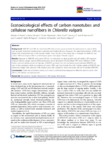Use este identificador para citar ou linkar para este item:
http://www.alice.cnptia.embrapa.br/alice/handle/doc/1010348| Título: | Ecotoxicological effects of carbon nanotubes and cellulose nanofibers in Chlorella vulgaris. |
| Autoria: | PEREIRA, M. M  MOUTON, L.   YÉPRÉMIAN, C.   COUTÉ, A.   LO, J.   MARCONCINI, J. M.   LADEIRA, L. O.   RAPOSO, N. R. B.   BRANDAO, H. de M.   BRAYNER, R.   |
| Afiliação: | HUMBERTO DE MELLO BRANDAO, CNPGL. |
| Ano de publicação: | 2014 |
| Referência: | Journal of Nanobiotechnology, Londres v. 12, n. 15, p. 1-13, 2014. |
| Conteúdo: | Background- MWCNT and CNF are interesting NPs that possess great potential for applications in various fields such as water treatment, reinforcement materials and medical devices. However, the rapid dissemination of NPs can impact the environment and in the human health. Thus, the aim of this study was to evaluate the MWCNT and cotton CNF toxicological effects on freshwater green microalgae Chlorella vulgaris. Results- Exposure to MWCNT and cotton CNF led to reductions on algal growth and cell viability. NP exposure induced reactive oxygen species (ROS) production and a decreased of intracellular ATP levels. Addition of NPs further induced ultrastructural cell damage. MWCNTs penetrate the cell membrane and individual MWCNTs are seen in the cytoplasm while no evidence of cotton CNFs was found inside the cells. Cellular uptake of MWCNT was observed in algae cells cultured in BB medium, but cells cultured in Seine river water did not internalize MWCNTs. Conclusions- Under the conditions tested, such results confirmed that exposure to MWCNTs and to cotton CNFs affects cell viability and algal growth. |
| Thesagro: | Microalga |
| Palavras-chave: | Bioindicador Nanopartícula Nanotoxicologia Uptake |
| Digital Object Identifier: | 10.1186/1477-3155-12-15 |
| Tipo do material: | Artigo de periódico |
| Acesso: | openAccess |
| Aparece nas coleções: | Artigo em periódico indexado (CNPGL)  |
Arquivos associados a este item:
| Arquivo | Descrição | Tamanho | Formato | |
|---|---|---|---|---|
| JournalofNanobiotechnologyVolume12issue12014doi10.1186147731551215PereiraMicheleMMoutonLudovicYepremianClaudeCouteEcotoxicologicaleffectsofcarbonnanotubesandce.pdf | 830,95 kB | Adobe PDF |  Visualizar/Abrir |









